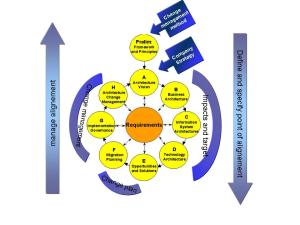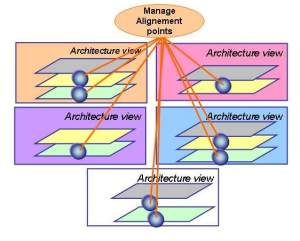I already wrote in a previous post how the number of papers discussing IT alignement suprised me. Indeed, for me, priority should be given to deciding, to planning and to setting up Enterprise Change.
Formerly, 15 years ago, Enterprise Change was contemplated by planning and launching big projects which frequently crashed. Then, best practises of IT led to break down big projects into pieces managed locally. It results an higher rate of success, but with some pieces left behind. By this time, Enterprise was rather a collection of stovepipes with more or less communication in between.
Some of us attempted to glue stovepipes with EAI and business process automation. They get a pretty complicated system which never had the expected flexibility required to follow users business changes.
Today, the reference is rather Boundaryless Information Flow™ : information is within the reach of every person who need to access it. Applications are broken down into services which each gives access to a piece of information.
Enterprise changes were, by earlier times, big chunks of process changes with projects involving large teams of developers for each. Today, the same changes involve a huge number of bits of software with a few developers each. Even if the overall people number is more or less the same, the minding is much more different.
That’s why today Strategic alignment concept best fit is managing enterprise wide changes. On the contrary, without wide changes, old controls based on classic project lifecycle – specifications, development and acceptance tests – are most of the time enough. We may remember that Henderson and Venkatraman publication title, in 1993, was “Strategic Alignment: Leveraging Information Technology for Transforming Organizations”.
Once you have decided to change, you should settle a method to manage transformations. You may choose for example Architecture Development Method from TOGAF. Once you have fulfilled the vision which set the final target of change, you start to model architecture. Each modelled structure is tied up to others by more or less complex links. Each links is a point of alignment : strategic alignment between goals and business or IT Strategy, IT alignment between process organisation and structure of Business and IT.
Alignment is a powerful concept for global enterprise transformation management because it is enough flexible to support projects reengineering instead of program management approach which may be disrupted. To be successful in using alignment, manager need to select the right set of alignment points which are critical for all dimensions of the change program : functions, costs, gains, security, reliability,…
For each alignment point, method for detecting or for identifying risks of misalignment should exist. As well, manager needs to know how to assess misalignment impacts on program objectives and what to do as corrective actions.
Alignment is very interesting because it acts on project production and no directly on project lifecycle. An approach based on it allows to control globally whole program consistency. It is also a set of indicators more understadable by business less keen to monitor project process. Used in addition to a comprehensive Enterprise architecture framework, like TOGAF, Alignement is a key success factor for Enterprise transformation


